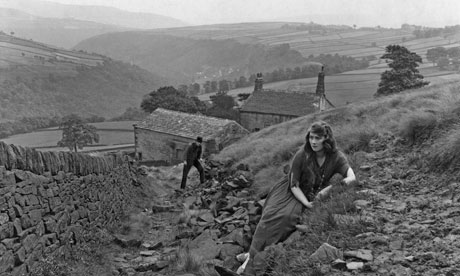Helen of Four Gates to get screening after 80-year hiatus
After global search for last remaining negative, Cecil Hepworth's 1921 classic to be shown in Yorkshire town where it premiered

A still from Helen of Four Gates starring the actor Alma Taylor in the title role. Photograph: BFI
Packed with 19th-century northern melodrama, from broody moors to cobbles, the 90-minute silent epic Helen of Four Gates was last shown in this country in the 1920s.
Based on a novel by a Yorkshire mill girl, who took the literary world by storm at the end of the first world war, the film had punters queuing at cinemas when it was released in 1921. Critics acknowledged the power of the much-clogged and be-shawled cast, and especially the landscape of Hebden Bridge in the Pennines where the pioneer director Cecil Hepworth did much of the filming.
But in spite of the accolades – which included a showing at the launch of Glasgow's Grosvenor Picture complete with organist and symphony orchestra – the reels suffered the fate of almost all Hepworth's work when his business collapsed. Starting in 1896 with a shed in his garden at Walton-on-Thames, Surrey, he expanded into studios which took over the whole street, but over-reached and went bankrupt in 1924.
"Most of his stock was melted down for the film's silver nitrate content," said Nick Wilding, a film-maker based in Heptonstall, overlooking the Hebden Bridge Picture House, where Helen of Four Gates is to have its 21st century debut next week. "There are other, shorter relics of his work, including a very early version of Alice in Wonderland made in 1904. But that's only ten minutes long. Helen is the real thing, a full-length feature film."
The new print organised by Wilding after more than five years' of global research, fund-raising and copyright negotiation, will also be shown in August as part at the British Film Institute's Long Live Film festival celebrating 75 years of their archive. It will then be lodged in the BFI's archive and kept available for future screenings, to avoid another 80-year viewing hiatus.
The print was taken from a negative traced by Wilding to the archive of the Cinémathèque Québécoise in Montreal, Canada, but the film's fragile state raised concerns about making a copy. Further sleuthing turned up one other print in New York, made from the Canadian negative many years earlier, but not to a very high standard.
Technical problems were eventually overcome and permission given for the showing at Hebden Bridge, where Hepworth premiered his original. The town has a copy of a special brochure produced for the occasion1, which used the Co-operative Hall to cram in hundreds of locals who had watched the then unfamiliar sight of camera crews immortalising their steep terraces and fustian mills.
"Helen is a very important film in the history of motion pictures," said Wilding. "The actress playing the title role, Alma Taylor, was one of the first to have the title of 'star', and she certainly earns it." Taylor was hugely popular from her earliest work as a child star in the Tilly comedies about a lively, prank-playing girl.
Helen's story is a classic of battered but unbowed northern women, based on the real-life experience of its author, Ethel Carnie Holdsworth. She was one of Britain's first authentically working-class novelists, earning international fame with her 1925 book This Slavery which was reviewed glowingly everywhere – the then Manchester Guardian called it "remarkable and distinctly original".
Wilding said: "She actually wrote the book here in Heptonstall, in her house across the street from mine. She brought Hepworth up here and showed him beautiful places on the moors such as Lumb Falls. That decided him on where to film.
"Helen is treated very badly by all the men in her life and there are some shocking scenes in the film, including the one in which she is whipped. It would be interesting to know the reaction of audiences in the early 1920s who were more used to seeing the likes of Charlie Chaplin."
"Life has certainly changed for women since then, but it is fascinating how unaltered our local landscape seems – it is dreamy and luscious in Hepworth's hands."
The return of the film also fulfils a long-held dream of Hepworth's daughter Valerie Williamson, who lived to see a series of takes but never the full version.
"She watched a 10-minute sequence of stills and music I compiled which included her father's introduction to the brochure handed to audiences at the premiere, 90 years ago," said Wilding. "She said she would always feel she had at last seen the film, even though she would probably not live to see the actual screening."
The film will be screened at Hebden Bridge Picture House on Thursday, 10 June, accompanied by live music
No comments:
Post a Comment
Please ensure your posts are appropriate in tone and content! All comments are reviewed by the blog owner before being published.